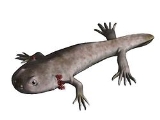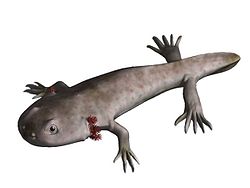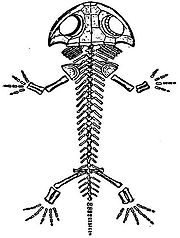
Branchiosaurus
Encyclopedia
Branchiosaurus is a genus
of small, lightly built early prehistoric amphibians. Fossil
s have been discovered in strata dating from the late Pennsylvanian
Epoch to the Permian
Period. The taxa may be invalid; the material referred to the genus may be juvenile specimens of larger amphibians.

 This tiny amphibian was very similar to the Rachitomi
This tiny amphibian was very similar to the Rachitomi
, differing primarily in size. Other distinguishing characteristics include a cartilaginous, less ossified skeleton
and a shorter skull. Clear traces of gill
s are present in many fossilized samples, hence the name.
Originally thought to have vertebrae distinct from rachitomous vertebrae, it was placed in a separate order named Phyllospondyli
("leaf vertebrae"). Later analysis of growth stages showed increasing ossification in larger specimens, which showed that at lest some of the species was the larval stage of much larger rachitomes like Eryops
, while others represent paedomorphic species which retained the larval gills in adulthood.
Distribution is uncertain, though available fossils come from central Europe, most famous of which are the Permian Niederkirchen Beds around Pfalz, Germany.
Genus
In biology, a genus is a low-level taxonomic rank used in the biological classification of living and fossil organisms, which is an example of definition by genus and differentia...
of small, lightly built early prehistoric amphibians. Fossil
Fossil
Fossils are the preserved remains or traces of animals , plants, and other organisms from the remote past...
s have been discovered in strata dating from the late Pennsylvanian
Pennsylvanian
The Pennsylvanian is, in the ICS geologic timescale, the younger of two subperiods of the Carboniferous Period. It lasted from roughly . As with most other geochronologic units, the rock beds that define the Pennsylvanian are well identified, but the exact date of the start and end are uncertain...
Epoch to the Permian
Permian
The PermianThe term "Permian" was introduced into geology in 1841 by Sir Sir R. I. Murchison, president of the Geological Society of London, who identified typical strata in extensive Russian explorations undertaken with Edouard de Verneuil; Murchison asserted in 1841 that he named his "Permian...
Period. The taxa may be invalid; the material referred to the genus may be juvenile specimens of larger amphibians.


Rachitomi
The Rachitomi were a group of extinct Palaeozoic labyrinthodont amphibians, according to an earlier classification system. They are defined by the structure of the vertebrae, having large, semi-circular intercentra below the notochord and smaller paired, though prominent pleurocentra on each side...
, differing primarily in size. Other distinguishing characteristics include a cartilaginous, less ossified skeleton
Bone
Bones are rigid organs that constitute part of the endoskeleton of vertebrates. They support, and protect the various organs of the body, produce red and white blood cells and store minerals. Bone tissue is a type of dense connective tissue...
and a shorter skull. Clear traces of gill
Gill
A gill is a respiratory organ found in many aquatic organisms that extracts dissolved oxygen from water, afterward excreting carbon dioxide. The gills of some species such as hermit crabs have adapted to allow respiration on land provided they are kept moist...
s are present in many fossilized samples, hence the name.
Originally thought to have vertebrae distinct from rachitomous vertebrae, it was placed in a separate order named Phyllospondyli
Phyllospondyli
The Phyllospondyli is a now abandoned term for a series of small, poorly ossified fossils of labyrinthodont amphibians. The groups was proposed as an order on the basis if their vertebrae, which was either consisting of neural arches over an otherwise unossified notocord or consisting of...
("leaf vertebrae"). Later analysis of growth stages showed increasing ossification in larger specimens, which showed that at lest some of the species was the larval stage of much larger rachitomes like Eryops
Eryops
Eryops meaning "drawn-out face" because most of its skull was in front of its eyes is a genus of extinct, semi-aquatic amphibian found primarily in the Lower Permian-aged Admiral Formation of Archer County, Texas, but fossils are also found in New Mexico and parts of the eastern United...
, while others represent paedomorphic species which retained the larval gills in adulthood.
Distribution is uncertain, though available fossils come from central Europe, most famous of which are the Permian Niederkirchen Beds around Pfalz, Germany.

